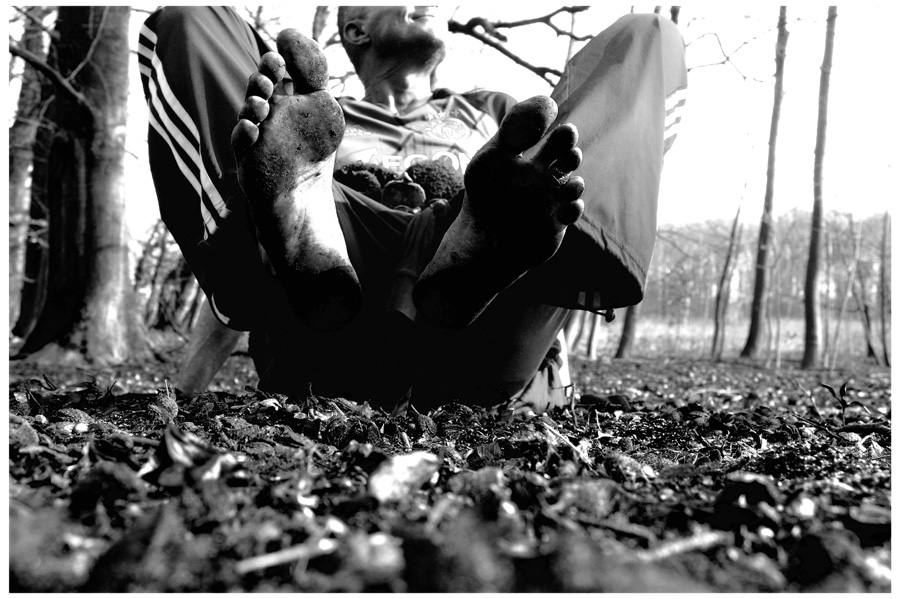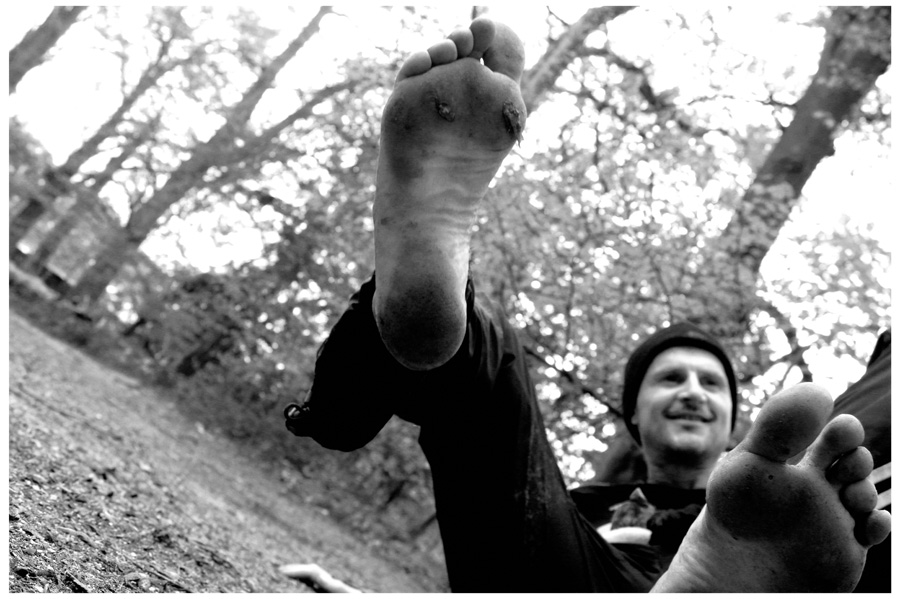Lucid dreaming
- Details
- Hits: 5719

Kennemer dunes 360° today. Catch [ the edge ]
Min/max temperature: 4°C/12°C; humidity: 55%; precipitation: 0 mm; sea level pressure: 1028.33 hPa; wind: SSE 22.0 km/h; visibility: 10.0 kilometres; Clouds: Few 426 m.
"Lucid dreams are also symbolic -- yet in quite a different way […] Their symbolism takes the form of beautiful landscapes -- different luminous phenomena, sunlight, clouds, and especially a deep blue sky. In a perfect instance of the lucid dream I float through immensely wide landscapes, with a clear blue, sunny sky, and a feeling of deep bliss and gratitude, which I feel impelled to express by eloquent words of thankfulness and piety. Sometimes these words seem to me a little rhetorical, but I cannot help it, as it is very difficult in dreams to control emotional impulses. Sometimes I conceive of what appears as a symbol, warning, consoling, approving. A cloud gathers or the light brightens. Only once could I see the disc of the sun […] I awoke fresh and cheerful, better in spirits than I had been for a long time."
Frederik van Eeden in the first extensive English-language scientific report on lucid dreams 'A Study of Dreams', published in the 'Proceedings of the Society for Psychical Research', Volume 26, 1913
"[T]here is the story of the great Taoist master Chuang Tzu who once dreamt that he was a butterfly fluttering around. In his dream, the idea that he was a person was alien to him: he was only a butterfly. Suddenly, he awoke and found himself lying there, a person once again. But then Chuang Tzu thought to himself, "Was I before a man who dreamt about being a butterfly, or am I now a butterfly who dreams about being a man?"
Manfred Kets de Vries in 'The Hedgehog Effect', page 53, first published in 2011 by John Wiley & Sons Ltd., United Kingdom
"In whatever the domain, the movements of a good, accomplished practitioner do not appear fast. For example, there are messengers who cover forty or fifty leagùes at the run in a single day, but they do not run fast from morning till night. Whereas, a beginner cannot cover such a long distance, even if he has the wind to run the whole day. […] Whatever the domain, the movements of an expert never appear hurried."
Miyamoto Musashi, in Kenji Tokitsu's 'Miyamoto Musashi. His Life and Writing', page 192, 193, first published in 2000 by Editions Desiris in Francepage
"[A]thletes need to gird themselves against […] contamination. Humility and gratitude seem to be the only effective shields against the onslaughts of […] exploitation. Athletes in the traditional martial arts employ specific exercises to overcome any tendency towards egotism. The dedication of one's skill, performance, or career to a higher principle provides the only absolute protection. [P]ower is characterised by grace, sensitivity, inner quit, and paradoxically, gentleness in the non-competitive lives of even fierce competitors."
David Hawkins in 'Power vs Force', page 182, first published in 1995 by Hay House UK Ltd
Wuwei
- Details
- Hits: 5641

Above: Haarlem, 52° 24' 3.7656'' North and 4° 38' 22.7148'' East, today.
"So it is said, he who practices the Way does less every day, does less and goes on doing less, until he reaches the point where he does nothing, and yet there is nothing which is not done. [...] Wuwei does not produce by effort or force but accomplishes trough allowing what wants to happen." (1)
"[ Wuwei ] is [...] a course of action [ free from ] any purposeful motive, gain or striving [ it is ] 'inaction'. Zhuang Zi himself [...] repeatedly cautions against a misconception of wuwei. When people hear about wuwei, he says, some think that "laying down is better than walking". They have missed the point completely [...]" (2)
"One must be able to let things happen. I have learned from the East what it means by the phrase "Wu-wei": namely, not-doing, letting be, which is quite different from doing nothing. Some Occidentals, also, have known what this not-doing means; for instance, Meister Eckhart, who speaks of "sich lassen," to let oneself be. [ W ] ait for what the unconsciousness has to say about the situation [...] A way is only the way when one finds it and follows it oneself." (3)
"Laziness of which a man is conscious and laziness of which he is unconscious, are a thousand miles apart." (4)
"When you are learning something the universe keeps giving you opportunities [ for practice] [ Mark Divine: Every emotion has a corresponding breathing pattern, right? ] The breathing wants to click into this pattern; [ so ] why don't we just use this breathing pattern and see if it triggers the transformation? And voilà, the technique was invented! You don't need a psychotherapist or psychiatrist or some expert. We try to keep the process simple […] just stay with the breathing, keep relaxing until it [ the transformation, healing ] resolves itself." (5)
"I’m lazy in principle" (6)

Above: picture of Anne Frank, dated 10 October 1942, reads: "Dit is een foto zoals ik me zou wensen, altijd zo te zijn. Dan had ik nog wel een kans om naar Hol[l]ywood te komen. Anne Frank 10 Oct. 1942" (This is a photo as I would wish myself to look all the time. Then I would maybe have a chance to get to Hollywood). Learn about Anne Frank: http://www.annefrank.org/en/Anne-Frank/
Above: Haarlem, today. Clicking on Image will start sound: Dutch Anthem performed and recorded by The United States Navy Band.
General Dwight D. Eisenhouwer's Proclammation: "Proclamatie. Nederlanders: De dag der bevrijding is aangebroken. Er ligt een lange harde weg achter u en ons. Tot nu toe hebben wij gescheiden van elkaar de strijd gevoerd Gij op uw wijze wij op de onze tezamen met onze heldhaftige Russische bondgenooten aan het Oostfront. […] Nu kunnen wij met Gods hulp gezamenlijk den vijand uit Uw land verdrijven en de eindoverwinning behalen. Onze soldaten zijn daartoe de Uwe en de Uwe zijn de onze." (Proclamation. To the people of The Netherlands: The day of liberation is close. There is a long, tough way behind you and us. Until now we have fought separately. You doing it your way and we on ours with our heroic Russian Allies on the Eastern front. […] With God's help we will join forces to defeat the enemy from your country and claim victory. Our soldiers will serve you, as yours will serve us.")

Above: Haarlem, May 4 (Remembrance Day), 2000 Hours.
See Original 1945 affiche: http://www.geheugenvannederland.nl/?/nl/items/NIOD01:48348
The United States Navy Band: http://www.navyband.navy.mil/national_anthems.shtml
_____________
(1) Zhuang Zi, quoted by Michael M. Tophoff on page 31 in 'Chan Buddhism: Implications of Awereness and Mindfulness-Training for Managerial Functioning', published in 2003
(2) Ibid, page 31
(3) C.G. Jung quoted by M. Esther Harding on page 44 of 'Psychic Energy', first published in 1947
(4) Ibid, page 45
(5) Dan Brulé, Unbeatable Mind Podcast with Mark Divine: https://itunes.apple.com/ca/podcast/unbeatable-mind-podcast-mark/id955637330
(6) From a conversation with Director of Photography Robby Müller: here (in English: here)
Undercurrent
- Details
- Hits: 5572

IJmuiden, 360° today. Structure [ team ]
Above: With Nico (the boss behind the desk) and mechanics Cees and Mike at TCY. Nico and his self-taught team are excellent car mechanics and pleasant people to deal with, located in the dunes, near the sea.
Min/max temperature: 6°C/11°C; humidity: 70%; precipitation: 0 mm; sea level pressure: 1016.14 hPa; wind: W 24.1 km/h; visibility: 10.0 kilometres; Clouds: Few 731 m., Scattered Clouds 1341 m.; Moon: Waxing Gibbous 95% illuminated
"[C]hilderen all over the world acquire languages with the same basic characteristics, in about the same sequence, at about the same age, almost regardless of their intelligence and almost regardless of their environment. [ This ] suggest that the basic forms of language -- the duality between phonemic and morphemic levels, the organisation of utterances into phrases, the transformation of phrase structure -- are somehow genetically inevitable. They are a model which experience can clothe, but cannot reshape. Just this was also the nativism of the Gestalt psychologists. They never argued that experience had no effects, but only that its effects were organised and determined by the deeper requirements of structure."
Ulric Neisser in 'Cognitive Psychology', page 247, first published in 1967 by Pretice-Hall, Inc., Englewood Cliffs, New Jersey
Today_footprint_clear_sunny_dune_full_beach_run
- Details
- Hits: 5607

Above: Cooling down after 28kms dune and full beach -- Swash, Face, Wrack and Berm -- run.
Sar_12(/14)_terminology
- Details
- Hits: 5533

Above: Footprints after todays 30K SAR12
"All good things come in fourteen's" - Anonymous
A
Alert - http://bartvanbroekhoven.com/en-US/running/51-introducing-sar-strategic-alert-running
B
Balance - http://bartvanbroekhoven.com/en-US/running/77-sar-10-threshold
Barefoot - http://bartvanbroekhoven.com/en-US/running/43-barefoot-trainers
Best Level - http://bartvanbroekhoven.com/en-US/running/78-sar-11-dirt-dive
C
CoG - http://bartvanbroekhoven.com/en-US/running/41-muiderslot
E
Efficiency - http://bartvanbroekhoven.com/en-US/running/75-sar-9-injury-control-interim-management
F
Flow - http://bartvanbroekhoven.com/en-US/running/38-wet-and-sandy
Food - http://bartvanbroekhoven.com/en-US/running/37-steaming-post-training-meal-suggestion See also: http://bartvanbroekhoven.com/en-US/running/60-clear-fresh-30kms-happy-feet See also: http://bartvanbroekhoven.com/en-US/running/58-today-40k-training-footprint-slow-wind-dry-clear-balanced?showall=&limitstart=
Frequency - http://bartvanbroekhoven.com/en-US/running/78-sar-11-dirt-dive
I
Intensity - http://bartvanbroekhoven.com/en-US/running/78-sar-11-dirt-dive
Injury - http://bartvanbroekhoven.com/en-US/running/15-viewer-discretion-advised-frostbite-7th-update-02-05 See also: http://bartvanbroekhoven.com/en-US/running/68-footprint-post-sar-2
O
Overload - http://bartvanbroekhoven.com/en-US/running/61-midsumer-saturday-morning-run-wind-sun-water-32kms
R
Rest (Recovery) - http://bartvanbroekhoven.com/en-US/running/68-footprint-post-sar-2
Running - http://bartvanbroekhoven.com/en-US/running/36-winter-fun
S
Strategic - http://bartvanbroekhoven.com/en-US/running/51-introducing-sar-strategic-alert-running
SAR - http://bartvanbroekhoven.com/en-US/running/75-sar-9-injury-control-interim-management
SOP - http://bartvanbroekhoven.com/en-US/running/68-footprint-post-sar-2
T
Technique - http://bartvanbroekhoven.com/en-US/running/67-30k-post-sar-footprint?showall=&start=1 See also: http://bartvanbroekhoven.com/en-US/running/34-today-in-the-trainings-factory
Treatment - http://bartvanbroekhoven.com/en-US/running/68-footprint-post-sar-2?showall=&limitstart=
W
Win (the game in the mind first) - http://bartvanbroekhoven.com/en-US/running/68-footprint-post-sar-2 See also: http://bartvanbroekhoven.com/en-US/running/15-viewer-discretion-advised-frostbite-7th-update-02-05



